ARGH — I had the same old marine electronics on my boat for, embarrassingly, an entire decade. Sure, it was a cool looking touchscreen MFD with side-scan, radar, and autopilot, but in today’s world of marine electronics it was rendered obsolete years ago. What’s worse was that I knew it.
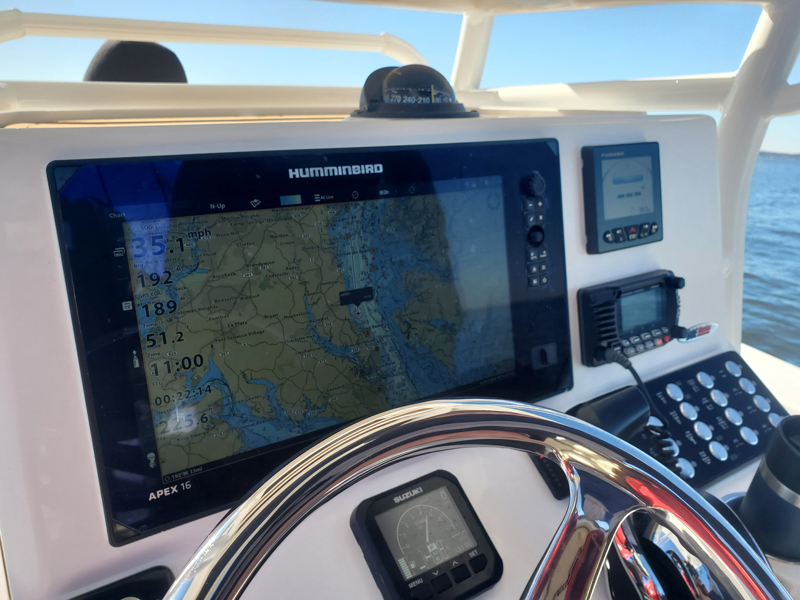
If your electronics suite is three or more years old, you’d probably benefit from an upgrade. If it’s five or more years old you’d notice a huge difference at the helm. And if it’s a decade old you’ll be beating yourself up for not having pulled the trigger on an upgrade sooner. Trust me on that last one. But, will an electronics upgrade really help you catch more, bigger fish? After starting fresh with a cutting-edge Humminbird electronics package on a new Caymas 26 HB this fall, the answer I give is a no-hesitation-or-question yes.
Side-Scan Fishfinders Then and Now
With my 10-year-old side-scan system I could locate structure off to the sides of my boat if and when I came close to it. In water under 10 feet, that meant passing within 40 or 50 feet did the trick. In deeper water I might be able to spot major items like bridge pilings or reefs from 100 or so feet. Occasionally I could spot wispy returns that I surmised may have been fish. I used it maybe 10 or 15 percent of the time, usually when I was trying to locate a particular piece of structure I knew was nearby but didn’t have exact coordinates for in my database.
With a new Humminbird Apex 16 MEGA SI+ at the helm, I’ve found the side imaging so much better — and so much more valuable — that I use it on nearly every trip. Shallow water structure appears in detail out to around 100 feet using the MEGA kHz setting, and it’s possible to pick up large items in deeper water clear out to several hundred feet. That said, I don’t yet have enough time on the water to feel qualified stating a useable maximum. So, I asked Humminbird’s ComMar rep Kevin Conroy for his thoughts on range abilities in the Chesapeake environment.
“I’d confidently say we can mark fish, structure, etc., to 600 feet total,” he said. “More is possible but it can vary depending on conditions, bottom hardness, depth, and other factors. You can get some more range on 455kHz but there is better detail with MEGA. Usually if the depth is over 50 feet of depth or you’re looking for many fish, that equals 455kHz. Searching for little wolf packs or a few fish off structure, on the other hand, equals using MEGA.”
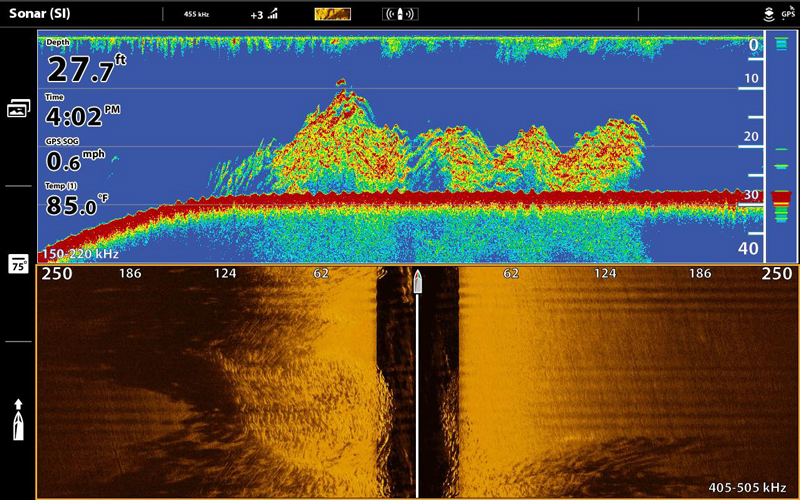
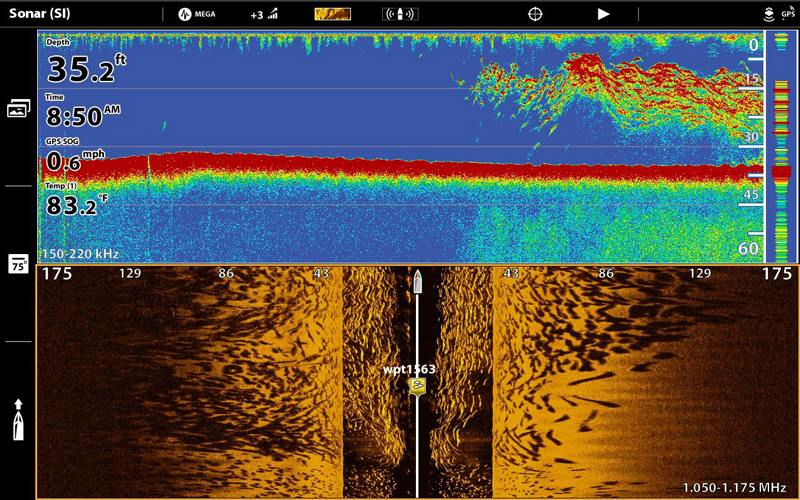
IMHO the biggest shocker in how this tech has progressed, however, is just how easy it is to spot specific fish. Rather than questionable wisps they appear as clear, hard targets, usually in an ovalish or elongated white form against the orange/white palette. It's possible to look at structure and say with confidence whether there are fish hanging around it, or not. And it’s possible to spot fish chasing bait off to either side of the boat, cast to ‘em, and catch ‘em.
“I adjust contrast and sensitivity a good bit,” adds Conroy, about spotting fish off to the sides. “A lot of what shows on the screen is due to depth and bottom hardness, and you’ll usually want lower sensitivity and higher contrast with a hard bottom like oysters or gravel, and higher sensitivity and lower contrast over soft, mucky bottom.”
My past exposure to side imaging with the Apex (or the modern Solix and Helix models) was limited to other people’s boats, which is probably an experience many of you have had. And it seems great in that scenario. But running the boat yourself while using it day after day is a very different experience from looking over someone’s shoulder between casts. This fall alone, I can point to multiple trips where side imaging changed a decision and we caught fish we wouldn’t have otherwise.
Downsides? There’s a learning curve to adapting to new electronics. A big learning curve. On the first few trips I was constantly apologizing to my crew for not knowing what the heck I was doing. In my estimation it took five to seven trips to get just the basics down pat, and at least 10 or so before I knew enough that I didn’t have to delay fishing to figure out how to make an adjustment or find a screen I wanted to pull up on the spot. Five months in I still feel like I’m very early in that curve.
Chartplotters Then and Now
Another big difference I’ve noted is in the chartplotter, something I never expected because chartplotter tech really hasn’t changed too much. So, where’s the advantage? The Apex came with CoastMaster chartography, introduced in 2021. The detail level of depth contours went from three feet to one foot, and while that may not sound like a huge difference, it means more subtle drops and edges jump out on-screen at a glance. Plus, integrated with the Minn Kota on the bow I can “tell” the electric trolling motor to follow those contours.
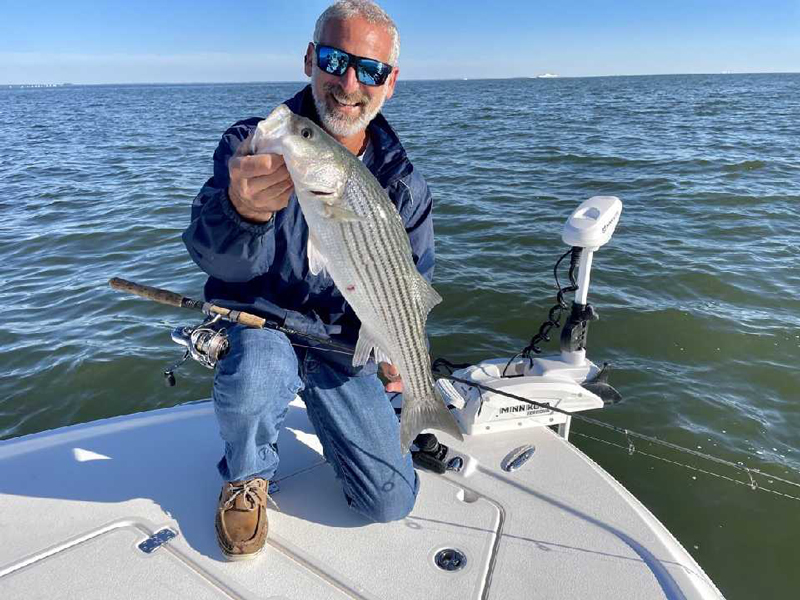
Boat Electronics Integration, Then and Now
Speaking of integration: having the trolling motor integrated with the MFD and being able to control it from the helm has turned out to be one of my favorite abilities, even though it’s one I never expected to utilize. Again, I’ve fished on plenty of boats with Minn Kota motors with Spot-Lock and appreciated it as an effective tool. But control generally came via a handheld remote. That seemed pretty slick, but it soon became apparent that running the Minn Kota from the MFD gives you some added advantage. It allows you to pinpoint-position the boat via chartplotter while “telling” it to go where you want on-screen. I can set it to slowly creep along the path of my choosing, or send it directly to a waypoint. Plus, the MFD never runs out of batteries like a remote can.
Another big bonus of a new, fully integrated system has also shown up in the form of enhanced radar functionality. The old radar was great, but required toggling between or splitting the screens while navigating in reduced visibility. Now, when the radar goes active its returns are overlaid directly on the chartplotter. It provides a huge on-screen view of what’s ahead without toggling or even thinking about how to best see both images at once.
On the flip side of the coin, integration with all these units doesn’t come cheap. Knowing that getting them to all play nicely together is often easier said than done, I even shelled out the cash for a professional installation and setup — for the first time in my life. You can certainly try installing an integrated system on your own, but those who have done so know that it can be an exercise in frustration.
Boat Electronics Screen Size, Then and Now
It’s pretty standard knowledge that when it comes to marine electronics, the bigger your screen size is, the better. It allows you to easily pick out details and returns on the fishfinder, present more screen-splits at a reasonable size, and display more data boxes without crowding out the other views. In this upgrade I went from an 11-inch screen to a 16-incher on the Apex.
That sounds like a nice improvement, though maybe not a massive one, right? Consider this: an 11-inch screen with a 16:9 aspect ratio has 51.7 square inches of LCD space. A 16-inch screen has 109.4. The difference is massive, indeed.
The crazy thing? This upgrade has become downright cheap compared to the past. For once, cost isn’t a downside but is actually an upside. A decade ago when Humminbird rolled out the Ion 12 (Helix and Solix hadn’t been born yet, much less Apex), it would have cost you around $3000. Today a Solix 12 MSRPs at around $2900. That’s a $100 drop, but 2012 dollars equal about $1.30 today. So when you consider the impact of inflation, that old 12-incher actually would have cost about $4800 in modern terms. In other words, upgrading from a 10-year-old system to a modern one you’ll be spending a little under 40-percent less for the same screen size as you had to a decade ago. Do some digging and you’ll find that this stealthy price rollback has taken place pretty much across the industry regardless of the specific manufacturer. Sweet!
Electronics Installation: Call a Pro, or No?
In the past I’ve always done all of my own electronics installations. But with a new boat, old knees and knuckles, and a high level of complexity, I decided to turn this job over to the pros. Since BOE Marine advertises in FishTalk (thanks!) and has a solid rep, they were my natural choice. They installed the flush-mount MFD, electric trolling motor and batteries, radar dome, Furuno NavPilot 300 autopilot and heading sensor, and VHF radio and antennae.
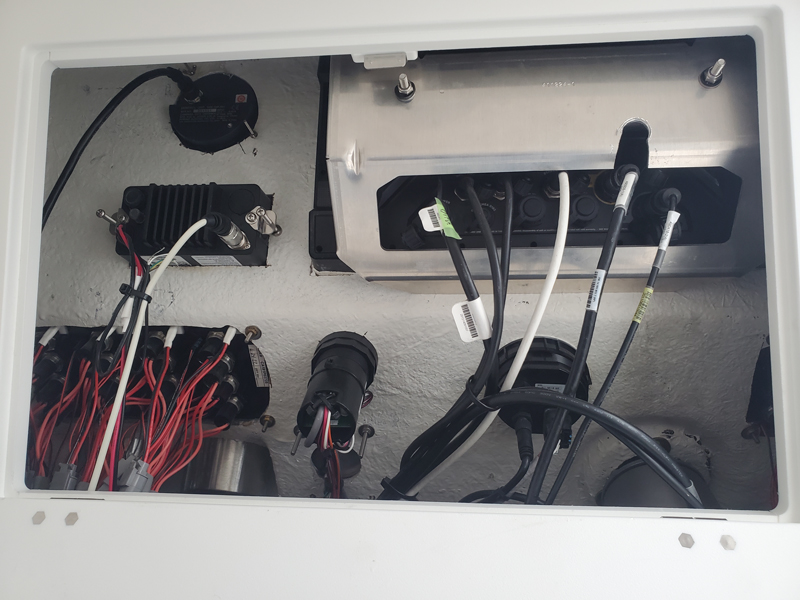
Net result? My personal hassle-factor plummeted to near zero, and the only time I had to lift a finger was to drop off and pick up the boat. The folks at BOE were stunningly competent from start to finish (ask for Emily or Vance), and they joined me on the boat for a sea trial and basic instruction. (Fishing was not involved! I swear!! Well okay, fishing was involved... But they do a sea trial for all their customers, regardless).
The biggest bonus for me was, without question, the fact that I didn’t have to pour over schematics, stress over making holes in the helm, or rip my hair out when something didn’t work right. It should also be noted that many owner-installations (including those done by myself) can feature iffy wiring, but BOE made everything tight and well-loomed so jiggly connections shouldn’t be a problem down the road. On top of that, mounting the radar posed a difficult problem due to the upper station and a frame that runs all the way back on the hardtop. But Emily ID’d the fix in a matter of moments and had the proper mast and mounting hardware on hand in days.

Is it worth shelling out the extra dough to call in the pros when you’re upgrading your electronics suite? Or, should you do it yourself and save the cha-ching? That’s your call. But after doing both I can tell you one thing for sure: the next time I need to install electronics on my boat, I’ll be reaching for my checkbook before I even think about reaching for my power drill.
Of course, we can’t promise you that you’ll catch more, bigger fish if you get an electronics upgrade. We’d guess it will help, but there are no guarantees in the world of fishing. There is one thing we can say for sure, however: get an upgrade, and you won’t spend the next 10 years beating yourself up over what you’ve been missing out on.
- By Lenny Rudow
Editor’s note: We did our best to lay out the facts as we see ‘em after using this gear and provide as comprehensive a view on this topic as possible. But in the interest of full disclosure we want to point out that that Humminbird does advertise in FishTalk (thanks guys!). You may favor a different brand, and that’s cool by us. But if your electronics are a decade old, chances are you’d benefit in at least some similar ways by upgrading to a modern package — regardless of who makes it and where they do or do not advertise.